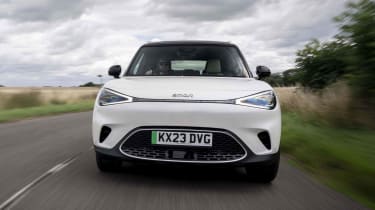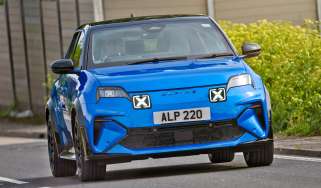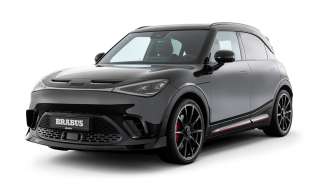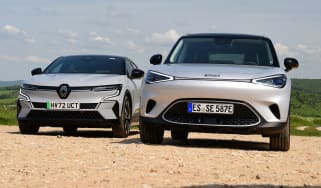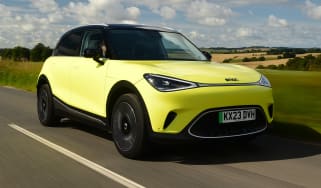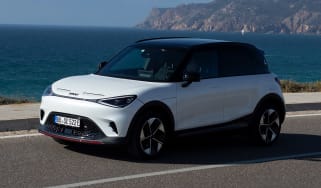Smart #1 review
Performance, efficiency and practicality are Smart #1 highlights, but it needs ride quality and infotainment improvements to best its rivals

Our opinion on the Smart #1
New starts are hard, but despite this, the Smart #1 shows plenty of promise as the Smart brand transitions to an electrified future. It’s got a spacious interior with a nifty sliding rear seat, an efficient electric drivetrain that helps get the most range out of its battery pack, and handsome styling. We also can’t knock it for over-delivering on performance compared with its rivals.
However, there’s still work to be done nailing down the ride and handling balance, especially in the case of the high-performance Brabus version, which isn’t what you want in a car with a sub-four-second 0-62mph acceleration time. Some quirks to its infotainment system need ironing out, and we’ve found its safety assistance technology to be highly annoying and a bit distracting while driving.
| Key specs | |
| Fuel type | Electric |
| Body style | Five-door compact SUV |
| Powertrain | 1x e-motor, 47kWh (usable) battery, rear-wheel drive 1x e-motor, 62kWh (usable) battery, rear-wheel drive 2x e-motor, 62kWh (usable) battery, four-wheel drive |
| Safety | 5-star EuroNCAP (2022) |
| Warranty | 3yrs/unlimited mileage |
About the Smart #1
Pricing for the Smart #1 starts at just under £30,000 for the Pure version with the smallest 49kWh (47kWh usable) battery pack. The larger 66kWh (62kWh usable) battery pack is available from the Pro+ trim and costs around £37,000, while the Premium trim, which includes the all-important heat pump and offers the longest electric range, is just over £39,500. The bonkers fast Brabus tops out at nearly £45,000, which is more than the entry-level BMW iX1.
Used - available now

2020 Land Rover
Range Rover
74,105 milesAutomaticDiesel4.4L
Cash £34,600
2020 BMW
5 Series
70,314 milesAutomaticPetrol2.0L
Cash £14,800
2022 Mercedes
CLA
17,581 milesAutomaticPetrol1.3L
Cash £26,600
2021 Ford
Focus
68,786 milesManualPetrol1.0L
Cash £11,300Along with differing battery sizes, there are two power outputs with the Smart #1: the standard single electric motor, rear-wheel drive model with 268bhp that’s available with Pure, Pro, Pro+ and Premium trims, or the high-performance Brabus model with two electric motors, giving you four-wheel drive and 422bhp.
As already alluded to, there are five trim levels, starting with the Pure trim. It comes with all the stuff you’d need, including 18-inch alloy wheels, LED head and tail lights, auto lights and wipers, blind spot monitoring, and traffic sign recognition. Upgrade to Pro trim for 19-inch wheels, a panoramic glass roof, artificial leather trim with front seat electric adjustment, an electric tailgate, adaptive cruise, dual-zone climate control, and ambient interior lighting.
Next up is Pro+ (not a caffeinated tablet), which gives you a larger battery pack. The Premium trim adds matrix LED headlights, a head-up display, a fancier sound system, wireless phone charging, and (most importantly) a heat pump. The Brabus trim mentioned above is the only way to get four-wheel drive, adds sportier exterior and interior design details on top of all the equipment a Premium trim provides.
If you're interested in getting yourself a Smart #1, we can help. Configure your ideal Smart #1 now to get top offers from local dealers, check out the latest Smart #1 leasing deals or search for used Smart #1 models with our Buy A Car service. You can even sell your existing car for a great price with Auto Express Sell My Car.
Electric motor, drive and performance
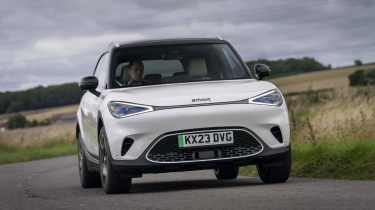
Pros |
Cons |
|
|
If what you want from your small electric SUV is a speedy getaway in the traffic light Grand Prix, then the Smart #1 is your car. However, we have many corners in this country, along with a wide range of road types of varying quality, so all this performance needs to be backed up by well-sorted suspension to keep things controlled.
Unfortunately, some work still needs to be done here. Things aren’t helped by the fact that the #1 (like all electric cars) has a heavy battery pack contributing to a not inconsiderable kerb weight (up to 1900kg in Brabus form). You’ll feel that weight because the soft suspension and under-damped shock absorbers of the #1 lead to an unsettled ride that struggles to control the car’s mass. We’ve found it to be bumpy at low speeds over potholes and speed bumps, demonstrates excessive body roll on twisty B roads, and has a tendency to feel bouncy at speed when loaded up.
There are three different settings for the steering weight, of which we think the middle ‘comfort’ option is best. Sport adds additional heft, but it’s a bit much for what most buyers will want from a small electric SUV – especially when parking in town.
We’re also disappointed by the regenerative braking system – an important part of an electric vehicle. Regenerative braking recoups some energy when slowing down for the battery that would otherwise be wasted as heat by the brakes of a normal car. In many EVs, like those from Tesla, as soon as you lift off the accelerator, the car slows in a predictable manner, leading to what many call a one-pedal driving mode. It can be a smooth way of slowing down, and you benefit from improving efficiency in the process.
However, the regenerative braking can be a little confusing in the #1. There’s a low and a high mode, but the latter isn’t strong enough for one-pedal driving, so you’ll be tempted to use the e-pedal setting (although that’s buried within a sub-menu). Unfortunately, this mode has an unpredictable delay between when you lift off the accelerator and the car starts to slow down. When it does so, it can be grabby, causing the nose to dip due to the car’s soft suspension. This makes it very hard to drive the #1 smoothly, leading to considerable frustration when behind the wheel, especially when trundling through stop/start traffic. The similarly sized Renault Megane E-Tech is much easier to get on with in this regard
That frustration will be increased by the nannying safety assistance systems that constantly interfere with the steering when travelling down a narrow country lane, and can get quite aggressive when you move out to try and give a cyclist a wide berth, for example. The driver attention monitor is also deeply frustrating because it can go off when looking to check that the coast is clear at a junction, or if you take a sip from a water bottle.
All isn’t lost for those who’ve set their heart on getting a Smart, the Smart #3 with its firmer suspension settings and longer wheelbase contributing to a much more settled and confidence-inspiring drive, and it still has the cute looks that make the #1 such an appealing proposition.
Performance, 0-60mph acceleration and top speed
If there are any lingering memories about the slow and jerky performance of old Smart cars, then the #1 will dispel them immediately. The all-electric drivetrain is much smoother given it doesn’t need to change gear, and the straight-line speed is a world away because even the least powerful model has 268bhp and surges through the 0-62mph sprint in 6.7 seconds – that’s the same as the hot-hatch rivalling Ford Puma ST.
If that isn’t enough, then there’s the even more bonkers Brabus version with 422bhp. Combined with the additional traction of four-wheel drive, it launches from 0-62mph in 3.9 seconds, outgunning even the more expensive BMW iX1 and plenty of high-performance petrol cars.
“The chassis in the Brabus version can come close to unravelling if you’re too harsh with your inputs; the front tyres break traction first, and then the system seems to start allowing some slip at the rear, before changing its mind. Let’s just say that you’ll end up squirting the Smart #1 Brabus between corners like a mini-GT, instead of pointing it at apices like a hot hatch. - John Mcllroy, former deputy editor
| Model | Power | 0-62mph | Top speed |
| Smart #1 Pro 49kWh | 268bhp | 6.7 seconds | 112mph |
| Smart #1 Brabus 66kWh | 422bhp | 3.9 seconds | 112mph |
Range, charging & running costs
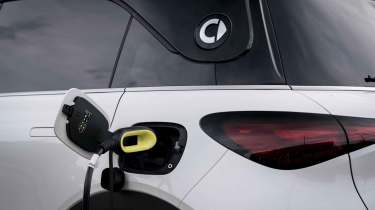
Pros |
Cons |
|
|
Electric range, battery life and charge time
The Smart #1 range starts with a 49kWh (47kWh usable) battery pack in the entry-level Pro version, while all other versions come with a 66kWh (62kWh usable) battery pack. The entry-level Pro model provides 193 miles of range, rising to 260 miles using the larger battery in the Pro+ model. This increases to 273 miles for the Premium model, while the top-of-the-range Brabus with four-wheel drive and additional power drops this down to 248 miles.
If you’re thinking it’s odd that the pricier Premium model goes further than the Pro+ version despite using the same size battery, that’s because a heat pump comes as standard on the former. This device is a much more efficient way of heating the interior of the car in cold weather, and provides a welcome boost in range. During our testing of a Premium trim test car against a Renault Megane E-Tech, our results suggested that over 230 miles of range in warmer weather is achievable.
The zero tailpipe emissions of the #1 mean it’ll be beneficial to company car drivers paying Benefit-in-Kind (BIK) rates, because it sits in the low three per cent category – at least until 2025. That’s much lower than similarly sized petrol or diesel small SUVs. Unfortunately, you will have to pay an annual vehicle excise duty (VED) tax to drive this EV, and you’ll need to choose your paint colour wisely on high-end Premium trim, otherwise you’ll break the £40,000 barrier where the luxury car tax surcharge applies. It's an additional fee you’ll pay over the standard rate of VED from the second time the vehicle is taxed, up until it is six years old.
The nippy electric car performance we described earlier means your insurance costs will be higher than the equivalent petrol or diesel alternative. The least expensive Pro is in group 30, while the high-performance Brabus is in group 38. That’s a lot higher than a regular petrol small SUV, such as the 1.0 TSI SE SEAT Arona, which is only in group nine. If you’re after an EV with lower insurance costs, a Vauxhall Mokka Electric starts in group 21, while the highly regarded Megane E-Tech starts in group 26.
Depreciation for the Smart #1 should be reasonable by class standards, according to our experts. Over three years and 36,000 miles, it should maintain between 42-47 per cent of its resale value. The Skoda Elroq performs slightly better than the #1 by retaining between 48-52 per cent of its value over the same period.
Find a suitably fast rapid charger, and you can top-up the 49kWh (47kWh usable) and 66kWh (62kWh usable) versions from 10-80 per cent charge in around 30 minutes. The smaller pack will take up to 130kW, while the larger one will take up to 150kW.
Most will probably use cheaper overnight electricity and charge up using a 7.4kW wallbox charger at home. The smaller battery pack will take up to 7.5 hours to fully recharge, while the larger capacity battery will take up to 10 hours to fully recharge a flat battery.
| Model | Battery size | Range | Insurance group |
| Smart #1 Pro 49kWh | 47kWh (usable) | 193 miles | 30E |
| Smart #1 Brabus 66kWh | 62kWh (usable) | 248 miles | 38E |
| Smart #1 Premium 66kWh | 62kWh (usable) | 273 miles | 32E |
Design, interior & technology
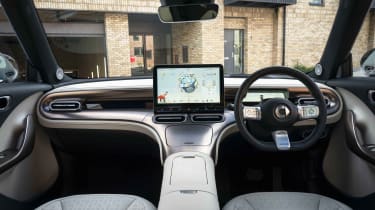
Pros |
Cons |
|
|
The exterior design for the #1 came from the European side of the partnership, while the Sustainable Experience Architecture (SEA) – all the mechanical bits beneath that handsome body – are the work of Geely. It’s a partnership that, on the face of it, looks to have worked well. The bold design is very premium looking, and the free two-tone paint scheme helps it stand out against competitors.
The interior is the highlight of the #1, because it resembles the work of a premium manufacturer. It certainly feels like co-parent brand Mercedes had a hand in the action of the cubby lids and the tactile-feeling buttons on the steering wheel. The clever use of bold shapes, textures, and the visual delight of the 64-colour ambient lighting help to distract from the inevitable cheaper plastics mounted lower down. Overall, the effect remains impressive, giving a fresh, modern, and minimalist look.
The driver has a 9.2-inch digital cluster tucked into the dashboard, which is a little on the small side. You can get around this by opting for a Premium trim with a head-up display, which projects important information directly onto the windscreen in your line of sight, meaning you don’t need to refocus your eyes from the road. The Volvo EX30 doesn’t get this handy feature, and you have to resort to looking over towards the central screen to find important information like what speed you’re going, because you don’t even get an instrument cluster in front of the driver.
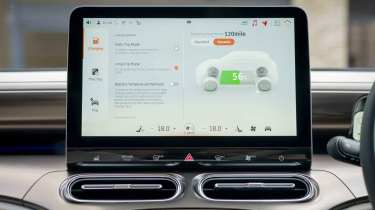
Infotainment, sat-nav and stereo
All versions of #1 get a 12.8-inch central touchscreen that’s reasonably responsive to your inputs. It has a rather busy-looking home screen that is a little difficult to navigate compared with the simpler sub-menus within the infotainment system, although we suspect that most will get used to it over an extended period. We did note that the animated fox (which acts as a home screen companion) was a little glitchy in the early build cars we’ve tested, so hopefully, this will be mended with an over-the-air software update.
Those initial cars we tried didn’t have Apple CarPlay and Android Auto smartphone capability, but we were promised that this would be sorted via an update, and any orders placed since October 2023 would have this connectivity upon delivery. There are four USB-C charging points (two up front, and two for rear seat passengers), while a wireless phone charging pad is provided from Premium trim and above.
The Beats sound system doesn’t really live up to the high-end ambitions you’d expect for an uprated speaker set-up. For its 640-watt output and 13 speakers, it’s a bit underwhelming to our ears.
“I’m not entirely convinced by the wireless phone-charging pad that comes as standard on our Premium-spec model. It does work, but if the phone moves slightly, it stops charging. Rather than worry about having to continually adjust the phone’s position, I’ve got around the problem by plugging a cable into one of the USB ports in the rear – it’s always good to have options.” – Dawn Grant, picture editor
Boot space, comfort & practicality
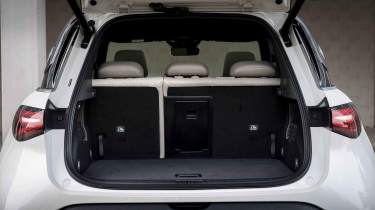
Pros |
Cons |
|
|
You sit quite high up in the Smart #1, and when combined with a large amount of glass all around, you have excellent visibility in all directions. All but the entry-level Pure trim gets front and rear parking sensors, plus a 360-degree camera system to help you out when parking. Space is good up front, with enough head, leg, and shoulder room for a pair of six-footers.
The high centre console has three separate lidded bins to give you many places to hide things from prying eyes. The front pocket can hold a smartphone, while the middle lid reveals a pair of cupholders. The largest space is at the back, with a long, deep area for storing larger items.
An Isofix point is mounted on the front passenger seat (ensure the passenger airbag is disabled when a rear-facing child seat is fitted), and two Isofix points are provided on the outer positions of the sliding rear bench.
There’s lots of legroom in the rear, and headroom is good despite the panoramic glass roof. We found more space in the back of the #1 than in the Megane E-Tech, which is undoubtedly helped by the sliding rear bench. The floor is flat with no central tunnel, so there’s plenty of foot space for three passengers. The one minor downside is that the seat backrests are quite firm.
| Dimensions | |
| Length | 4,270mm |
| Width | 1,822mm |
| Height | 1,636mm |
| Number of seats | 5 |
| Boot space | 323 litres (313 litres Brabus) |
Boot space
At only 323 litres (Premium and Brabus models lose 10 litres due to the Beats Audio system’s subwoofer), the boot appears small compared to the 440 litres provided by the Megane E-Tech. However, the boot floor of the #1 is level with the bumper, making it less of a hassle to heave heavier items over the awkward loading lip in the Renault. Additionally, the #1 features a neat, square-shaped boot area with a wide opening, making it quite useful.
You can always slide the rear seats forward for a little more capacity, or fold them down completely. Doing so increases the volume to 986 litres (976 litres for Premium and Brabus models) – and that figure measures only to the window line rather than the roof. There’s a decent amount of extra storage under the false boot floor, and the #1 also has an additional storage space under the bonnet – ideal for storing dirty or wet charging cables and keeping them away from your luggage in the boot.
Towing
Aside from the entry-level Pro model, all two-wheel drive 66kWh and four-wheel drive Brabus models have a 1,600kg braked towing rating, which is good for an electric car. If you need to pull greater weights, you’ll either need a pricer electric car, like the Kia EV6 with its 1,800kg tow rating, or head back to a fossil fuel vehicle such as the petrol SEAT Ateca, because that can lug around 1,700kg.
“I’m starting to warm to the huge centre console because it creates three very practical storage areas, all with sliding covers. Up front, the smallest cubby includes wireless phone charging in our Premium-spec car, while the middle one has two cup-holders, and the large storage space behind can work as a mini cooler – handy for keeping snacks chilled. Beneath the console is the perfect slot for my handbag – much better than having it on the seat or in the front passenger footwell.” – Dawn Grant, picture editor
Safety & reliability
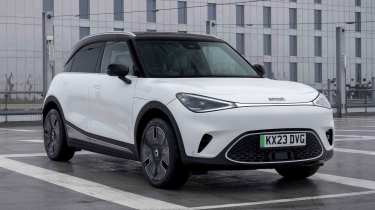
Pros |
Cons |
|
|
The Smart #1 received a maximum five-star rating from safety experts EuroNCAP. It scored better than the Megan E-Tech in all areas. It even beats the pricier Nissan Ariya in most areas apart from the ‘vulnerable road users’ and ‘safety assist’ categories.
You get a lot of safety technology as standard, including adaptive cruise control to keep you a safe distance from the vehicle in front, a lane-keeping assist system to help keep you within your lane, and also intervene if you’re about to collide with a vehicle travelling alongside you in your blindspot, and a cross-traffic alert system to warn you of vehicles crossing your path when reversing or entering a main road from a junction.
It’s a bit early to say what the reliability of the #1 will be because it’s the first of a new line-up of Smart cars built on a new platform. It’s also built at a different manufacturing plant in China, whereas all previous Smart cars were built in a factory in Hambach, France. From a superficial build quality standpoint, we’ve so far been impressed with certain aspects of the fit and finish of the #1, such as the damping of the few interior buttons it has, and the action of all the covers on the centre console. Some cheaper plastics are used inside, but that criticism can also be levelled at far pricier electric rivals to the #1.
| Key standard safety features | Euro NCAP safety ratings |
|
Buying and owning
Best buy: Smart #1 Pro
We’d advise avoiding the most powerful Brabus version because it doesn’t cope with its power, and instead go for the Pro trim. While it doesn’t go as far on a charge as the Premium trim with its bigger battery and more energy efficient heat pump, the price of the Pro is much more competitive with our preferred version of Skoda Elroq. Pro trim comes with more equipment than our preferred SE L 60 Elroq, and has the handy sliding rear seats that are missing on the Pure trim #1.
For those looking to go further, the Premium trim does have the most range of all the #1’s available, but it costs more than the Edition 85 Elroq, which has a significantly larger capacity battery (77kWh usable versus 62kWh) than this version of #1, giving the Skoda over 300 miles of range. The Smart is below this milestone, at 273 miles.
Smart #1 alternatives
As with its immediate predecessor, the latest Smart #1 is a collaboration between different manufacturers. Mercedes is still a joint owner, but Chinese car manufacturer Geely is also in the mix, along with Volvo and Zeeker. These combined efforts have developed the Sustainable Experience Architecture (SEA) platform that not only underpins this Smart #1, but the Volvo EX30 and Zeeker X as well. It has also spawned the Smart #3, and will continue to underpin other future models for the brand.
Price-wise, the Smart #1 goes up against one of our favourite small electric SUVs, the Hyundai Kona Electric, which is a better all-round package with a much bigger boot. Then there are the more comfortable and better handling choices such as the Cupra Born, Renault Megane E-Tech, and Volkswagen ID.3, plus there’s the Kia EV3 and our 2025 Car of the Year, the Skoda Elroq to consider.
Deals on the Smart #1 and alternatives
Smart #1 Premium long-term test
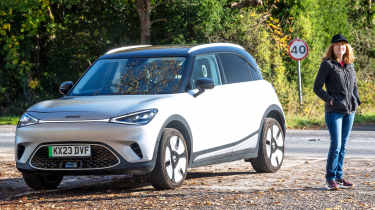
Our picture editor, Dawn Grant, ran a Smart #1 Premium as part of a long-term test. She found the #1 to be spacious enough for her needs, and it proved to be nippy enough around the streets of London.
However, her early car had a few issues. Some of them were resolved with software updates, but there were also some hardware issues, such as the driver’s heated seat not working and a misaligned bonnet.
Smart #1 pictures
Frequently Asked Questions
We think the Pro trim is the one to go for because its lower price keeps it competitive with our preferred SE L 60 Skoda Elroq. The #1 comes with more equipment than the Elroq, which helps soften the blow that it can’t match the range of the Skoda.

